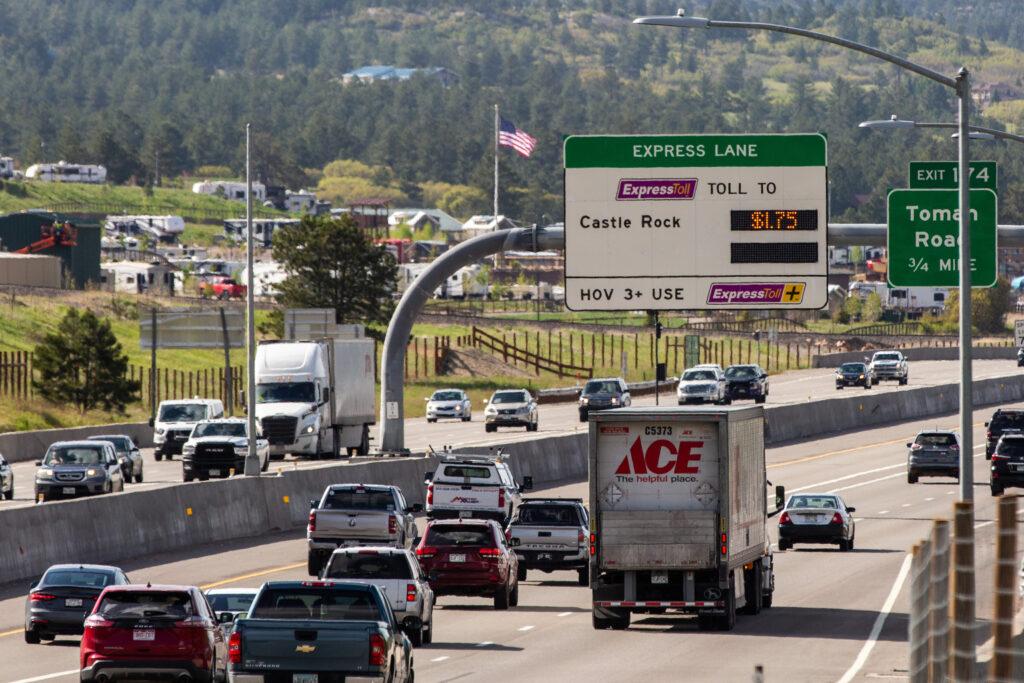
Rudy Lukez was somewhere around Larkspur when he thought his life was going to end.
The Highlands Ranch dad had picked up his son and one of his son’s friends and was driving north on Interstate 25 when he decided to try the relatively new toll lane that the Colorado Department of Transportation opened late in 2021.
Lukez settled in at 80 mph — just over the posted 75 mph speed limit. A driver in a large truck was soon on his tail, flashing their lights and blasting the horn. But, knowing that the state now tickets drivers for weaving in and out of some toll lanes, Lukez didn’t want to cross the double white lines to move into slower lanes.
He felt trapped.
“I actually thought I was going to die in the toll lane,” Lukez said.
He white-knuckled it until he could legally move out of the toll lane. When he did, Lukez said, the aggressive driver floored it. Lukez was seething — both at the other driver and the state for designing a system with uneven enforcement that seemed to work against itself.
So he asked CPR News’ Colorado Wonders: Can toll lane drivers go as fast as they want? Why is the state’s automated enforcement system set up to catch toll lane weavers, but not toll lane speeders?
“There seems to be just this overall attitude that when you pay … you are also now somehow entitled to Autobahn speeds,” he said.
Let’s start with the basics: Yes, toll lanes, like every other highway, have speed limits.
And yes, it’s illegal to exceed them.
“You do not get to drive as fast as your car will go on an express lane,” said CDOT spokesperson Tim Hoover.
But data shows that drivers do indeed speed on Colorado’s toll lanes, though not enough to make it an “urgent safety concern” according to a recent analysis conducted for the agency by Blissway. That company operates the automated enforcement cameras on a growing number of Colorado’s toll lanes.
Blissway’s report, which CPR News obtained via an open records request, found that nearly 24 percent of drivers caught weaving in and out of toll lanes also were clocked going more than 75 mph — but just 3.6 percent were going faster than 85 mph. Lane-weavers make a good proxy for all toll lane users, Blissway added.
“It does take a single driver to cause a potentially fatal accident, but speeding propensity on Colorado’s express lanes seems low to moderate,” Blissway analysts wrote.
Still, a significant number of toll lane users say they don’t feel safe in them — nearly 30 percent, according to a recent survey. CDOT’s Hoover also said he’s had a tailgating experience similar to Lukez’ on I-25 near Larkspur.
“I feel his pain, unfortunately,” Hoover said, adding: “You try to ride it out and just see if eventually you can get over.”

It turns out that Lukez could have steered out of the toll lane early without being fined — though officials discourage that. The I-25 toll near Larkspur doesn’t yet have the automated camera system that tickets lane-weavers. When that system is activated, which could happen later this year, Hoover expects it will reduce aggressive driving there as it has in other corridors.
“Once you are able to crack down on weaving, it even kind of helps control the speed some because weaving is really associated with really bad behavior, speeding, tailgating, all that kind of stuff,” Hoover said.
State law keeps the existing enforcement cameras from catching speeders. But true speed cameras could be coming soon
Colorado’s growing network of toll lanes — or express lanes, as CDOT would like you to call them — are actually owned and operated by the Colorado Transportation Investment Office.
That’s a government-owned business within CDOT that the legislature created, in part, to sidestep the Colorado Taxpayer’s Bill of Rights. TABOR, as it’s also known, limits how much revenue governments in Colorado can collect and spend and requires all proposed tax increases to go to a popular vote.
The transportation investment office, however, has its own legal limitations. It can levy tolls and use that money to finance and build toll lanes. It can fine drivers for weaving in and out of toll lanes because they are evading tolls — it’s issued $40 million in those citations in the last nine months.
But, Hoover said, the investment office doesn’t have the legal authority to enforce speeding in toll lanes or the adjacent free lanes.
The legislature, however, recently gave CDOT itself and the Colorado State Patrol the explicit legal authority to use automated speed cameras on highways — including toll lanes. CDOT has plans to take advantage of that starting with construction zones, Hoover said.“If and when CDOT and CSP begin deploying speed safety cameras, we will want to ensure enforcement is applied equally across all travel lanes of a road, not simply Express Lanes,” Hoover said.









